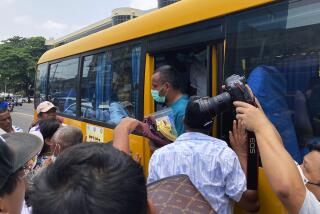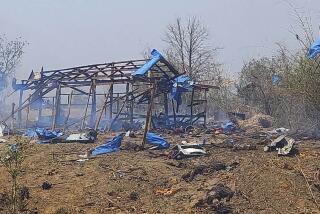200 Burmese Airmen Join Rally in 1st Key Defection
- Share via
BANGKOK, Thailand — About 200 enlisted men of the Burmese air force joined an anti-government rally at Rangoon University this morning, the first time a large group of uniformed military men had taken part in the swelling protests against Burma’s government.
According to reports from Rangoon, the air force men--sergeants and privates but no officers--apparently sneaked off their base to join students demanding the ouster of Burma’s military-dominated regime.
In past weeks, particularly in provincial towns outside the capital, soldiers have been reported taking part in protest marches, but only in small numbers. Diplomats and other analysts say the unity of the 180,000-man armed forces has been the last bastion of strength for the ruling party, and they express fears that any large-scale mutiny could lead to widespread bloodshed.
Meanwhile, a letter surfaced in Rangoon this morning, purportedly written by U Nu, Burma’s first prime minister and nominal head of a new opposition alliance. The letter listed names for an interim Cabinet and called for multi-party elections on Oct. 9.
Among the names was Tin Oo, a former defense minister, who is a member of the alliance. The list did not include well-known oppositionists Aung Gyi, a one-time ally of Burmese strongman Ne Win, or Aung San Suu Kyi, the daughter of independence leader Aung San. Both have taken a high profile in the anti-government demonstrations.
Aung Gyi has been quoted as warning that “the rivers of our country will run with blood” if the military splinters.
It was not clear whether the letter, if genuine, was an attempt by U Nu to proclaim a provisional government, but his past statements have indicated that he favors a less provocative course to bring democracy to Burma.
Follows Demonstrations
Today’s developments followed another day of massive street demonstrations against the regime, when hundreds of thousands of students and workers filled the streets of the capital, demanding the ouster of the government.
Also Thursday, continued walkouts at the Rangoon airport stalled American plans to evacuate the families of U.S. Embassy personnel.
With commercial flights canceled because of airport strikes, diplomatic sources said military transport planes are ready to fly to Rangoon to pick up 95 American dependents. A U.S. spokesman said that “we are considering contingency arrangements for transporting the dependents of American personnel from Rangoon,” but declined to say whether two big American C-141 transports at the Bangkok airport will be used.
Other Preparations
At least six other countries were reported to be preparing to remove their dependents from the Burmese capital as disorder grows in the continuing political crisis.
Thursday’s massive demonstrations were largely peaceful, in contrast to Wednesday’s violence.
Billed as the first day of a general strike to force the formation of an interim government, the opposition protests attracted widespread support. By some estimates, as many as 1 million protesters marched in Rangoon, a city of 3.5 million.
Anti-government Burmese blame the ruling party and a military autocracy for political repression and failed economic policies that have transformed their once-prosperous country into one of the world’s poorest nations.
As they converged on the downtown area Thursday, marchers waved banners and shouted slogans.
“Our cause, our cause” and “Democracy now,” they chanted in Burmese.
Some students marched under a banner carrying a slogan not seen before in months of anti-government protests. It said: “We Will Fight for Democracy.”
President Mocked
Housewives marched with pots and pans to mock President Maung Maung’s remark that women were being abandoned to household chores by their politically active husbands.
Army units, which had moved back onto the streets of Rangoon on Wednesday to put down widespread looting, made no move to block Thursday’s demonstrations.
Patrols were withdrawn, and soldiers moved to assembly areas in school grounds and stadiums around the capital.
More to Read
Sign up for Essential California
The most important California stories and recommendations in your inbox every morning.
You may occasionally receive promotional content from the Los Angeles Times.









